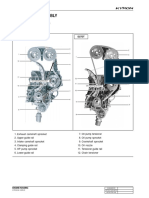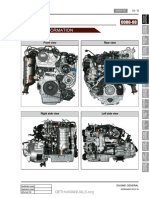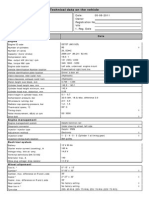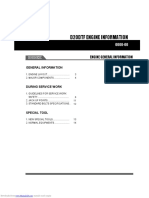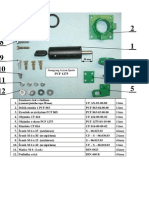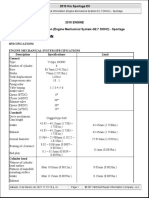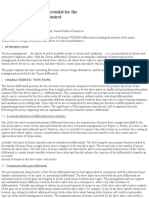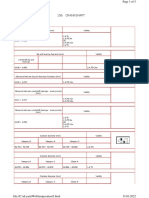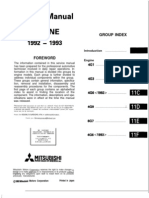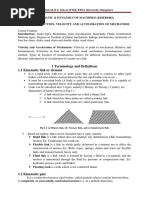(Ssangyong) Manual de Taller Ssangyong Actyon 2001
(Ssangyong) Manual de Taller Ssangyong Actyon 2001
Uploaded by
serccons S.A.SCopyright:
Available Formats
(Ssangyong) Manual de Taller Ssangyong Actyon 2001
(Ssangyong) Manual de Taller Ssangyong Actyon 2001
Uploaded by
serccons S.A.SOriginal Description:
Original Title
Copyright
Available Formats
Share this document
Did you find this document useful?
Is this content inappropriate?
Copyright:
Available Formats
(Ssangyong) Manual de Taller Ssangyong Actyon 2001
(Ssangyong) Manual de Taller Ssangyong Actyon 2001
Uploaded by
serccons S.A.SCopyright:
Available Formats
2 02
CYLINDER HEAD/CYLINDER BLOCK
CYLINDER HEAD
Cylinder head bolt
Oil Return Check Valve
System Characteristics
1. 4-valve DOHC valve mechanism
2. Swirl and tangential port
3. 4-bolt type cylinder head bolt
4. Water jacket integrated casting
5. Integrated chain housing and cylinder head
Intake manifold Exhaust manifold
6. Oil gallery: drilled and sealing with cap and screw plug
ENGINE HOUSING CHANGED BY
ACTYON SM - 2006.03 EFFECTIVE DATE
AFFECTED VIN
02 3
Cylinder Head Pressure Leakage Test
GENERAL
Preceding Works:
1. Removal of cylinders
2. Removal of intake and exhaust manifold
ASSY
3. Removal of valves
Test Procedures
HOUSING
1. Place the pressure plate on a flat-bed work bench.
EXHAUST I N T A K E
LUB
2. Install the cylinder head on the pressure plate.
Tightening torque 60 Nm
COOLING
3. Immerse the cylinder head with the pressure plate
into warm water (approx. 60°C) and pressurize with
compressed air to 2 bar.
FUEL
NOTICE
CONTROL
• Examine the cylinder head for air bubbling. If the air
bubbles are seen, replace the cylinder head.
SENSOR
Cylinder Head Mating Surface Check
Specifications
Height “A” (cylinder head parting surface - cylinder head cover parting surface) 140.9 ~ 141.1 mm
Minimum height after machining 140.9 mm
Flatness In longitudinal direction 0.075 mm
In transverse direction 0.075 mm
Permissible variation of parallelism of top parting surface to bottom in longitu-
within 0.1 mm
dinal direction
Peak-to-valley height 0.004 mm
Valve recess “a” Intake valve 0.74 ~ 0.86 mm
Exhaust valve -0.15 ~ 0.15 mm
CHANGED BY ENGINE HOUSING
EFFECTIVE DATE ACTYON SM - 2006.03
AFFECTED VIN
4 02
Measurement
1. Measure the cylinder head height “A”.
Limit Over 140.9 mm
NOTICE
• If the height is less than the limit, the cylinder head
must be replaced.
2. Insert the valves into the valve guides and measure
the recesses.
Valve recess “a” Intake Valve 0.74 ~ 0.86
Exhaust Valve -0.15 ~ 0.15
NOTICE
• If the measured value is out of the specified range,
machine the valve seat as much as necessary un-
til the specified value is achieved.
ENGINE HOUSING CHANGED BY
ACTYON SM - 2006.03 EFFECTIVE DATE
AFFECTED VIN
02 5
GENERAL
Cylinder Head
Disassembly
Preceding Works:
ASSY
1. Disconnect the negative battery cable.
2. Apply the parking brake and place the chocks under
the tires. (transmission “N” position)
HOUSING
EXHAUST I N T A K E
1. Remove the EGR pipe.
LUB
COOLING
2. Disconnect the injector fuel lines, connector and
FUEL
preglow plug connector. Remove the cylinder head
cover.
CONTROL
CAUTION
• Cover the openings of fuel line with the protective
caps.
SENSOR
3. Rotate the crankshaft pulley to align the OT marks.
1) Align the mark (notch) on sprocket for cylinder
No.1 (exhaust) and for cylinder No.6 (intake).
(align the cylinder No.1 OT)
CHANGED BY ENGINE HOUSING
EFFECTIVE DATE ACTYON SM - 2006.03
AFFECTED VIN
6 02
4. Mark on the timing chain, intake camshaft sprocket
and exhaust camshaft sprocket for timing setting
during installation.
5. Remove the chain tensioner after removing the EGR
pipe and oil dipstick.
6. Remove the high pressure pump and mark on the
high pressure pump sprocket.
7. Remove the camshaft position sensor.
ENGINE HOUSING CHANGED BY
ACTYON SM - 2006.03 EFFECTIVE DATE
AFFECTED VIN
02 7
8. Hold the camshafts and remove the intake camshaft
GENERAL
sprocket and exhaust camshaft sprocket.
ASSY
HOUSING
EXHAUST I N T A K E
9. Remove the upper guide rail with a sliding hammer.
LUB
COOLING
10. Remove the oil cooler and the intake manifold.
11. Remove the cylinder head bolts according to the FUEL
CONTROL
SENSOR
numerical sequence.
1) M8 x 25: 2EA
2) M8 x 50: 2EA
3) M12 x 177: 9EA
4) M12 x 158: 1EA (vacuum pump side)
CHANGED BY ENGINE HOUSING
EFFECTIVE DATE ACTYON SM - 2006.03
AFFECTED VIN
8 02
12. Remove the cylinder head.
CAUTION
• Inspect the cylinder head mating surface.
• Store the removed injectors and glow plugs so that
they will not be damaged.
• If there is a sign of oil leakage on the cylinder head
gasket, replace it with new one.
13. Measure the piston protrusion from the mating
surface.
Standard 0.765 ~ 1.055 mm
ENGINE HOUSING CHANGED BY
ACTYON SM - 2006.03 EFFECTIVE DATE
AFFECTED VIN
02 9
Reassembly
GENERAL
1. Measure the length of cylinder head bolts.
1) If the maximum length is exceeded by 2 mm,
replace the cylinder head bolt.
ASSY
HOUSING
EXHAUST I N T A K E
2. Install the cylinder head with the steel gasket.
NOTICE
• Make sure to place the “TOP” mark upward.
LUB
COOLING
3. Tighten the cylinder head bolts to specified torque
FUEL
and torque angle.
Step 1: 20 ± 2.0 Nm
CONTROL
Tightening torque Step 2: 85 ± 5.0 Nm
Step 3: 360° (120° x 3) + 10°
SENSOR
NOTICE
• Apply the oil on the bolt thread when installing.
• Always insert new washer first.
• The bolts at vacuum pump side are shorter than others.
4. Pull the timing chain over the cylinder head and install
the upper guide rail.
NOTICE
• Make sure that the convex surface of upper guide
rail faces to front side
• Be careful not to alter the timing point of high pres-
sure pump.
CHANGED BY ENGINE HOUSING
EFFECTIVE DATE ACTYON SM - 2006.03
AFFECTED VIN
10 02
5. Install the intake and exhaust camshaft sprockets
and the timing chain.
Tightening torque 25 Nm + 90°
NOTICE
• If the sprocket bolt is stretched over 0.9 mm, re-
place it with new one.
• Always install the intake camshaft sprocket first.
1) Make sure that the upper guide rail is installed
with proper direction.
2) Make sure that the timing chain is securely
seated on the guide rails.
NOTICE
• Make sure that the markings on camshaft sprocket
and timing chain are aligned.
6. Install the chain tensioner.
Tightening torque 65 ± 5.0 Nm
NOTICE
• Make sure that the EGR steel gasket is properly
installed.
ENGINE HOUSING CHANGED BY
ACTYON SM - 2006.03 EFFECTIVE DATE
AFFECTED VIN
02 11
7. Rotate the crankshaft pulley two revolutions and
GENERAL
ensure that the OT mark on the crankshaft pulley
and the OT mark on the camshaft pulley are aligned.
ASSY
NOTICE
• If the markings are not aligned, reinstall the cylin-
der head.
HOUSING
EXHAUST I N T A K E
8. Install the cylinder head cover and the high pressure
pump housing.
NOTICE
• Apply the sealant on the bolt threads when install-
ing the high pressure pump.
LUB
COOLING
9. Remove the protective caps from the injector and
FUEL
install the new fuel supply pipes.
NOTICE
CONTROL
• The fuel pipes are not reusable to keep the clean-
ness and parts damage.
SENSOR
CHANGED BY ENGINE HOUSING
EFFECTIVE DATE ACTYON SM - 2006.03
AFFECTED VIN
12 02
Intake/Exhaust-Removal/Installation
1. Remove the cylinder head assembly.
2. Install the removed cylinder head on the assembly
board (special tool) and set the supporting bar and
lever (special tool) on the cylinder head.
3. Push the valve spring seat down with the lever and
remove the valve cotter, valve seat and valve spring.
4. Remove the valves from the cylinder head.
ENGINE HOUSING CHANGED BY
ACTYON SM - 2006.03 EFFECTIVE DATE
AFFECTED VIN
02 13
Special Tools and Equipment
GENERAL
Name and Part Number Application
Y99220092B
ASSY
Compression pressure measuring
adapter and gauge
HOUSING
EXHAUST I N T A K E
Y99220082B
Supporting bar and lever
LUB
COOLING
Y99220162B
FUEL
Guide pin extractor
CONTROL
SENSOR
Y99220112B
Intake manifold guide pin
CHANGED BY ENGINE HOUSING
EFFECTIVE DATE ACTYON SM - 2006.03
AFFECTED VIN
14 02
CAMSHAFT ASSEMBLY
Preceding Work: Removal of cylinder head cover
Intake Camshaft and
Finger Follower and HLA Exhaust Camshaft Camshaft Sprockets
Cylinder Head
Camshaft Position Sensor Chain Tensioner
ENGINE HOUSING CHANGED BY
ACTYON SM - 2006.03 EFFECTIVE DATE
AFFECTED VIN
02 15
Camshaft Position Sensor
GENERAL
Gap
ASSY
HOUSING
EXHAUST I N T A K E
Hall voltage
<Location of Camshaft Position Sensor> <Operation Principle of Hall Sensor>
The camshaft position sensor uses hall-effect to set the camshaft position and metallic-magnetic-material sensor
end is attached on the camshaft and then rotates with it. If sensor protrusion passes camshaft position sensor’s
LUB
semi-conductor wafer, magnetic field changes direction of electron on the semi-conductor wafer to the current flow
direction that passes through wafer from the right angle. When operation power is supplied from camshaft position
sensor, camshaft hall sensor generates signal voltage. The signal voltage will be 0V if protrusion and camshaft
COOLING
position sensor are near and 5 V if apart.
ECU can recognize that the No. 1 cylinder is under compression stroke by using this voltage signal (hall voltage).
The rotating speed of camshaft is half of the crankshaft and controls engine’s intake and exhaust valves. By install-
ing sensor on the camshaft, can recognize specific cylinder’s status, compression stroke or exhaust stroke, by
FUEL
using camshaft position when the piston is moving toward TDC (OT). Especially when started first, it is difficult to
calculate the stroke of a specific cylinder with only crankshaft position sensor.
Accordingly, camshaft position sensor is necessary to identify the cylinders correctly during initial starting. However,
CONTROL
when engine is started, ECU learns every cylinder of the engine with crankshaft position sensor signals so can run
the engine even though the camshaft position sensor is defective during engine running.
Pulse generation Cam angle ± 6°
SENSOR
Sensor air gap 0.45 ~ 1.80 mm
Tightening torque 10 ~ 14 Nm
Operating temperature - 40 ~ 130°C
Ground
Camshaft sensor
<Circuit Diagram of Camshaft Position Sensor>
CHANGED BY ENGINE HOUSING
EFFECTIVE DATE ACTYON SM - 2006.03
AFFECTED VIN
16 02
Disassembly
Preceding Works:
1. Disconnect the negative battery cable.
2. Apply the parking brake and place the chocks under
the tires. (transmission “N” position)
1. Remove the EGR pipe.
2. Disconnect the injector fuel lines, connector and
preglow plug connector. Remove the cylinder head
cover.
CAUTION
• Cover the openings of fuel line with the protective
caps.
3. Rotate the crankshaft pulley to align the OT marks.
1) Align the mark (notch) on sprocket for cylinder
No.1 (exhaust) and for cylinder No.6 (intake).
(align the cylinder No.1 OT)
ENGINE HOUSING CHANGED BY
ACTYON SM - 2006.03 EFFECTIVE DATE
AFFECTED VIN
02 17
4. Mark on the timing chain, intake camshaft sprocket
GENERAL
and exhaust camshaft sprocket for timing setting
during installation.
ASSY
HOUSING
EXHAUST I N T A K E
5. Remove the chain tensioner after removing the EGR
pipe and oil dipstick.
LUB
COOLING
6. Remove the high pressure pump and mark on the
FUEL
high pressure pump sprocket.
7. Remove the camshaft position sensor. CONTROL
SENSOR
CHANGED BY ENGINE HOUSING
EFFECTIVE DATE ACTYON SM - 2006.03
AFFECTED VIN
18 02
8. Hold the camshafts and remove the intake camshaft
sprocket and exhaust camshaft sprocket.
9. Remove the camshaft bearing cap bolts so that
the tightening force can be relieved evenly.
1) Exhaust: #1, #3, #5
2) Intake: #6, #8, #10
However, there is no specific removal sequence.
3) Do not remove the bolts at a time completely.
Remove them step by step evenly or camshaft
can be seriously damaged.
4) Remove the exhaust camshafts and then
remove the intake camshaft.
• Exhaust: #2, #4
• Intake: #7, #9
10. Remove the finger follower and the HLA device.
Finger Follower
HLA
ENGINE HOUSING CHANGED BY
ACTYON SM - 2006.03 EFFECTIVE DATE
AFFECTED VIN
02 19
GENERAL
Reassembly Finger Follower
1. Install the HLA device and finger follower. Check
the HLA device with the diagnosis procedures before
ASSY
installation.
NOTICE
HOUSING
• Perform the air bleeding process if it has been
stored for a extended period of time.
HLA
• Make sure that it is properly installed on the locat-
ing pin.
EXHAUST I N T A K E
2. Place the bearing cap with the OT marks on both
camshafts facing upward.
NOTICE
• Apply the sealant on the cap (#12) for the vacuum
pump when installing.
LUB
Part number: 661 989 56 A0 (DB2210)
• Apply the oil on the bearing journals before
installation.
COOLING
3. Tighten the camshaft bearing cap bolts.
FUEL
1) Intake: #7, #9
2) Exhaust: #2, #4
3) Intake: #6, #8, #10 CONTROL
SENSOR
4) Exhaust: #1, #3, #5
Tightening torque 25 Nm
NOTICE
• Check the finger follower positions and align if
needed.
CHANGED BY ENGINE HOUSING
EFFECTIVE DATE ACTYON SM - 2006.03
AFFECTED VIN
20 02
4. Install the intake and exhaust camshaft sprockets
and the timing chain.
Tightening torque 25 Nm + 90°
NOTICE
• If the sprocket bolt is stretched over 0.9 mm, re-
place it with new one.
• Always install the intake camshaft sprocket first.
1) Make sure that the upper guide rail is installed
with proper direction.
2) Make sure that the timing chain is securely
seated on the guide rails.
NOTICE
• Make sure that the markings on camshaft sprocket
and timing chain are aligned.
5. Install the chain tensioner.
Tightening torque 65 ± 5.0 Nm
NOTICE
• Make sure that the EGR steel gasket is properly
installed.
ENGINE HOUSING CHANGED BY
ACTYON SM - 2006.03 EFFECTIVE DATE
AFFECTED VIN
02 21
6. Rotate the crankshaft pulley two revolutions and
GENERAL
ensure that the OT mark on the crankshaft pulley
and the OT mark on the camshaft pulley are aligned.
ASSY
NOTICE
• If the markings are not aligned, reinstall the cylin-
der head.
HOUSING
EXHAUST I N T A K E
7. Install the cylinder head cover and the high pressure
pump housing.
NOTICE
• Apply the sealant on the bolt threads when install-
ing the high pressure pump.
LUB
COOLING
8. Remove the protective caps from the injector and
FUEL
install the new fuel supply pipes.
NOTICE
CONTROL
• The fuel pipes are not reusable to keep the clean-
ness and parts damage.
SENSOR
CHANGED BY ENGINE HOUSING
EFFECTIVE DATE ACTYON SM - 2006.03
AFFECTED VIN
22 02
Special Tools and Equipment
Name and Part Number Application
Y99220152B
HLA remover
Y99220142B
Stem seal installer
ENGINE HOUSING CHANGED BY
ACTYON SM - 2006.03 EFFECTIVE DATE
AFFECTED VIN
02 23
TIMING CHAIN ASSEMBLY
GENERAL
Chain Drive System
ASSY
System Layout
HOUSING
EXHAUST I N T A K E
Oil injecting direction
LUB
COOLING
FUEL
CONTROL
1. Exhaust camshaft sprocket 7. Oil pump tensioner
SENSOR
2. Upper guide rail 8. Oil pump sprocket
3. Intake camshaft sprocket 9. Crankshaft sprocket
4. Clamping guide rail 10. Oil nozzle
5. HP pump sprocket 11. Tensioner guide rail
6. Lower guide rail 12. Chain tensioner
CHANGED BY ENGINE HOUSING
EFFECTIVE DATE ACTYON SM - 2006.03
AFFECTED VIN
24 02
Chain
1. Chain type: Double Bush
2. Pitch: 9.525 mm
3. Load limits: 19,000 N
4. No. of links: 148 EA
5. Overall length: 1409.7 mm
6. Replace when the chain is extended by 0.5 % from overall length (Replace if extended by over 7.0485 mm)
Chain Tensioner
Check valve
* Check valve opening pressure: 0.2 ~ 0.5 bar
The major function of tensioner is optimizing the movement of chain drive system by using spring constant and oil
pressure in the tensioner.
The tensioner performs function of adjusting chain tension to be always tight, not loose, while engine running. By
doing so, can reduce wears of each guide rail and sprocket.
65 ± 5.0 Nm
Tightening torque
(Installed on the cylinder head)
Guide Rail
Guide rail is used to optimize the movement of chain drive system like tensioner.
Guide rail can prevent chain slap when chain is extended and reduce chain wears.
Guide rail is needed especially when the distance between the sprockets are too long.
The material is plastic.
1. Location of guide rail
1) Tensioner guide rail: Between crankshaft sprocket and exhaust camshaft sprocket
2) Upper guide rail: Between exhaust camshaft sprocket and intake camshaft sprocket
3) Clamping guide rail: Between intake camshaft sprocket and HP pump sprocket
4) Lower guide rail: Between HP pump sprocket and crankshaft sprocket
ENGINE HOUSING CHANGED BY
ACTYON SM - 2006.03 EFFECTIVE DATE
AFFECTED VIN
02 25
Timing Setting
GENERAL
ASSY
HOUSING
EXHAUST I N T A K E
LUB
Sprocket
marking:
4 points
COOLING
(Gold marking)
FUEL
CONTROL
1. Check marking links on the chain (Gold marking)
2. Locate a point with two continuous marking links and align it to a marking on crankshaft sprocket ( )
SENSOR
3. Align respective marking link to each camshaft sprocket (intake and exhaust) marking ( )
4. Align another marking link to HP pump sprocket marking ( )
CHANGED BY ENGINE HOUSING
EFFECTIVE DATE ACTYON SM - 2006.03
AFFECTED VIN
26 02
Removal and Installation
1. Remove the cylinder head assembly.
2. Remove the oil pan.
3. Remove the chain guide rail with a sliding hammer.
4. Remove the chain cover.
5. Remove the oil pump drive chain.
6. Remove the upper guide rail while pushing the
retaining spring with a screwdriver.
7. Remove the lower guide rail.
8. Remove the oil pump drive chain.
9. Remove the tensioner guide rail.
10. Remove the timing chain.
11. Install in the reverse order of removal.
NOTICE
• Thoroughly clean the removed components before
installing.
ENGINE HOUSING CHANGED BY
ACTYON SM - 2006.03 EFFECTIVE DATE
AFFECTED VIN
02 27
CYLINDER BLOCK
GENERAL
ASSY
Deep head bolt thread to prevent the
deformation at cylinder bore surfaces
HOUSING
EXHAUST I N T A K E
LUB
Water jacket design to in-
crease the cooling efficiency
COOLING
FUEL
CONTROL
Cambering type skirt to reduce the noise
SENSOR
CHANGED BY ENGINE HOUSING
EFFECTIVE DATE ACTYON SM - 2006.03
AFFECTED VIN
28 02
System Characteristics
1. Rib design by considering strength against engine vibrations and weight
2. Cambering type skirt design on case housing wall to reduce the engine noise
3. Water jacket design to increase the cooling efficiency of cylinder bore bridge
4. Deep head bolt thread to prevent the deformation at cylinder bore surfaces
5. Reinforcement of strength
1) Main bearing housing / Main bearing cap
2) Extended main bearing cap bolt
6. Reducing the noise, vibration and harshness (NVH)
1) Minimize the vibration by adding external ribs
2) Adding the ribs around oil pan mating surface
Knock Sensor
Two knock sensors are located on the cylinder block (intake manifold side).
To detect engine vibration under abnormal combustion, knock sensor has piezoelectric element fixed on the
vibration plate and this vibration plate is fixed on the base. If happens knocking, pistons or connecting rods
vibrate and occurs heavy sounds that hit metal. Knock sensor is used to detect those knockings caused by
abnormal combustions. It controls idling stabilities and turns on the engine warning light when detects injector
damages. And also controls pilot injection very precisely during MAP learning.
When knock sensor is defective, engine ECU corrects injection timing based on MAP values like engine speed,
intake air volume and coolant temperature.
Before checking the knock sensor unit, be sure to check the tightening torque of the sensor and connector
connecting conditions.
Insulating resistance Min. 1 MΩ
Resonance frequency 25 kHz
Operating temperature - 40 ~ 150°C
26 ± 8 mV/g (at 5 kHz)
Output voltage 22 ~ 37 mV/g (3 ~ 10 kHz)
22 ~ 57 mV/g (10 ~ 20 kHz)
Tightening torque 20 ± 5 Nm
ENGINE HOUSING CHANGED BY
ACTYON SM - 2006.03 EFFECTIVE DATE
AFFECTED VIN
02 29
GENERAL
ASSY
HOUSING
EXHAUST I N T A K E
<Location of Knock Sensor>
1. Sensor housing 6. Upper contact plate
2. Nut 7. Piezo element
3. Disc spring 8. Lower contact plate
LUB
4. Weight 9. Body
5. Insulation disc 10. Terminal
COOLING
FUEL
NOTICE
CONTROL
• The knock sensor should be tightened with the specified tightening torque. Otherwise, the engine output may
be decreased and the “ENGINE CHECK” warning lamp may come on. The internal resistance of the sensor is
approx. 4.7 kW.
SENSOR
Ground
Knock
sensor
Signal
Signal
Knock
sensor
Ground
(Except D20DT)
<Circuit Diagram of Knock Sensor>
CHANGED BY ENGINE HOUSING
EFFECTIVE DATE ACTYON SM - 2006.03
AFFECTED VIN
You might also like
- SsangYong Actyon Service Manual PDFDocument2,172 pagesSsangYong Actyon Service Manual PDFVictor Abel Ovalle Retamal94% (36)
- BMW X6 2010 N63 4.4l - Torques de ApertoDocument16 pagesBMW X6 2010 N63 4.4l - Torques de ApertoBruno SantosNo ratings yet
- Engine Torque Settings and Spec's 3.0L V6 SCDocument4 pagesEngine Torque Settings and Spec's 3.0L V6 SCMario Maravilla50% (2)
- G4na 2.0 L Nu Mpi MTDocument460 pagesG4na 2.0 L Nu Mpi MTAngel Gabriel Galván100% (2)
- Hyundai Veracruz 3.8 2009Document63 pagesHyundai Veracruz 3.8 2009Salud y Cuidado Automotriz100% (1)
- Sqr477f Engine MechanicalDocument88 pagesSqr477f Engine Mechanicalarriaza.marcoNo ratings yet
- Tabla de Torques de Motor Mahindra 2.2Document2 pagesTabla de Torques de Motor Mahindra 2.2ivanNo ratings yet
- Sincronizacion de Motores Ssangyong d20dt d27dtDocument4 pagesSincronizacion de Motores Ssangyong d20dt d27dtMynor Witt100% (5)
- Manual de Mecánica Ssangyong Korando C200 Del 2010 Al 2019Document1,162 pagesManual de Mecánica Ssangyong Korando C200 Del 2010 Al 2019kevin andres marimon vega100% (2)
- Especificaciones de Servicios Kia G6da g6db PDFDocument180 pagesEspecificaciones de Servicios Kia G6da g6db PDFOliver Eduardo100% (1)
- Torques Captiva 2.4Document7 pagesTorques Captiva 2.4rectificamos100% (2)
- Manuel Atelier Sherco 300 SEF-R 2015 PDFDocument75 pagesManuel Atelier Sherco 300 SEF-R 2015 PDFbouvret100% (1)
- 2013 Kia Soul (Gasoline 1.6 GDI) - Engine Mechanical SystemDocument154 pages2013 Kia Soul (Gasoline 1.6 GDI) - Engine Mechanical Systembakriramzi100% (1)
- Especificaciones Sssangyong Rexton 2.7 Xdi CRDocument2 pagesEspecificaciones Sssangyong Rexton 2.7 Xdi CRAmadeus De La Cruz0% (1)
- Motor+Hyundai+G6EA GSL+2.7Document101 pagesMotor+Hyundai+G6EA GSL+2.7ecomotrixes100% (2)
- Manual Motor Action+d20dtDocument182 pagesManual Motor Action+d20dtPamela MontesNo ratings yet
- Manual de Servico - Motor - QQ 10Document40 pagesManual de Servico - Motor - QQ 10Renan Oliveira100% (3)
- Engine: 303-01C Engine - 3.2L Duratorq-Tdci (148Kw/200Ps) - Puma 2011 - 2014 Ranger AssemblyDocument23 pagesEngine: 303-01C Engine - 3.2L Duratorq-Tdci (148Kw/200Ps) - Puma 2011 - 2014 Ranger AssemblyCamille Fajardo Danganan100% (2)
- Manual Motor d20dt KyronDocument442 pagesManual Motor d20dt KyronAnderson Bombista100% (1)
- D20Dtf Engine InformationDocument16 pagesD20Dtf Engine InformationFrancisco Alejandro TelloNo ratings yet
- Azera 2016 Engine RepairDocument186 pagesAzera 2016 Engine RepairReza Varamini0% (1)
- KIA CARNIVAL-SEDONA 2009 - ENGINE MECHANICAL SYSTEM - D 2.9 VGT - en PDFDocument150 pagesKIA CARNIVAL-SEDONA 2009 - ENGINE MECHANICAL SYSTEM - D 2.9 VGT - en PDFJuanCarlosMartinez100% (1)
- m74 Vs m78Document57 pagesm74 Vs m78CajamaticNo ratings yet
- Hyundai Santa Fé 2.7L 2008 - Cabeçote - Remoção Recolocação PDFDocument31 pagesHyundai Santa Fé 2.7L 2008 - Cabeçote - Remoção Recolocação PDFLeonardo Limberger0% (1)
- Sincronizacion de Motores Ssangyong d20dt d27dt PDFDocument4 pagesSincronizacion de Motores Ssangyong d20dt d27dt PDFMynor WittNo ratings yet
- C210 WML 201Document13 pagesC210 WML 201Efrén SantínNo ratings yet
- Ssang Yong ActyonDocument31 pagesSsang Yong Actyonlinx_bvNo ratings yet
- Medidas 3.2D (Duratorq - Puma)Document3 pagesMedidas 3.2D (Duratorq - Puma)Flavia CossetinNo ratings yet
- Cf1275-Ssang Yong Actyon Sports Mr. 2008 TiptronicDocument3 pagesCf1275-Ssang Yong Actyon Sports Mr. 2008 TiptronicSergejNo ratings yet
- D20Dtf Engine: 1. SpecificationDocument26 pagesD20Dtf Engine: 1. SpecificationKada Ben youcefNo ratings yet
- Dsi 6 A-T PDFDocument46 pagesDsi 6 A-T PDFmanualNo ratings yet
- SsangYong Actyon 2008 Service Repair Manual PDFDocument2,425 pagesSsangYong Actyon 2008 Service Repair Manual PDFDavid CalugaruNo ratings yet
- Calado Distribucion Motor Land Rover Jaguar 2.0 DDocument187 pagesCalado Distribucion Motor Land Rover Jaguar 2.0 DCHEMA BASAN100% (3)
- 12 Euro III Engine-N900 Series JMCDocument91 pages12 Euro III Engine-N900 Series JMCRusonegro100% (1)
- Motor Korando g20dfDocument36 pagesMotor Korando g20dfNicolas MendezNo ratings yet
- F9Q Timing BeltDocument12 pagesF9Q Timing BelttomasNo ratings yet
- Tightening Torques: Dv4C, Dv6C, Dv6Dted, Dv6Eted, Dv6Uc, Dv6 Ue6 EnginesDocument24 pagesTightening Torques: Dv4C, Dv6C, Dv6Dted, Dv6Eted, Dv6Uc, Dv6 Ue6 EnginesKamen Kamenov100% (1)
- Sportage 2010 2.7LDocument120 pagesSportage 2010 2.7LPiero PalominoNo ratings yet
- Toyota 2c Pares de Apriete PDFDocument2 pagesToyota 2c Pares de Apriete PDFIrwin Frank100% (1)
- Tucson 2010Document92 pagesTucson 2010edi100% (2)
- (TM) Ssangyong Manual de Taller Ssangyong Actyon 2013 en Ingles (1) - 201-300Document100 pages(TM) Ssangyong Manual de Taller Ssangyong Actyon 2013 en Ingles (1) - 201-300LUIS HERNANDONo ratings yet
- (TM) Ssangyong Manual de Taller Ssangyong Actyon 2013 en Ingles (1) - 501-600Document100 pages(TM) Ssangyong Manual de Taller Ssangyong Actyon 2013 en Ingles (1) - 501-600LUIS HERNANDONo ratings yet
- Bk2q-9k546-Ag 20190701 115501Document2 pagesBk2q-9k546-Ag 20190701 115501คุณชายธวัชชัย เจริญสุขNo ratings yet
- (SSANGYONG) - Manual - de - Taller - SSANGYONG - Actyon - 2012 D20DTRDocument182 pages(SSANGYONG) - Manual - de - Taller - SSANGYONG - Actyon - 2012 D20DTRpatricio100% (1)
- Injection Pump Test SpecificationsDocument3 pagesInjection Pump Test SpecificationsEdinson Ariel Chavarro QuinteroNo ratings yet
- Injection Pump Test SpecificationsDocument4 pagesInjection Pump Test SpecificationsJunior IungNo ratings yet
- MT D2.5Document26 pagesMT D2.5Mario Acevedo100% (1)
- Actyon PDFDocument321 pagesActyon PDFPapi CruzNo ratings yet
- Chapter 2Document25 pagesChapter 2Qibal Pradana100% (1)
- Dsi 6 Speed Auto TransaxleDocument24 pagesDsi 6 Speed Auto TransaxleKada Ben youcefNo ratings yet
- Montagem Motor 2.2 LDocument37 pagesMontagem Motor 2.2 LJose Luis Toco100% (2)
- Toyota 5l Valve ClearanceDocument5 pagesToyota 5l Valve ClearancedennoNo ratings yet
- Crs Triton Common Rail System OkDocument78 pagesCrs Triton Common Rail System OkPps Bubakan100% (2)
- SsangYong Actyon 2008 Service Repair Manual PDFDocument10 pagesSsangYong Actyon 2008 Service Repair Manual PDFFelipe Perez YañezNo ratings yet
- Motore d20dt d27dtDocument139 pagesMotore d20dt d27dtGONTONINo ratings yet
- Rexton Y200Document1,627 pagesRexton Y200Xuân Hùng NguyễnNo ratings yet
- Z8 (CF800) Service Manual 2013 (057-211) (037-150)Document114 pagesZ8 (CF800) Service Manual 2013 (057-211) (037-150)francisco jose ramirez perezNo ratings yet
- Valve Clearance: AdjustmentDocument10 pagesValve Clearance: AdjustmentDannyDDannyD100% (1)
- GX100 Ajuste de MotorDocument1 pageGX100 Ajuste de MotorThu Naing TunNo ratings yet
- Overhaul: 1. Remove Valve LifterDocument13 pagesOverhaul: 1. Remove Valve LifterMark Anthony FletcherNo ratings yet
- MSA5T0122A27579Document8 pagesMSA5T0122A27579miguelNo ratings yet
- J.P. Rizal Ext. West Rembo, Makati CityDocument2 pagesJ.P. Rizal Ext. West Rembo, Makati CityJustine Nicole MahabaNo ratings yet
- Spare Parts Jurop PNR 124 DDocument8 pagesSpare Parts Jurop PNR 124 DpurchasingNo ratings yet
- Bergamont: Translation of The Original Operating InstructionsDocument80 pagesBergamont: Translation of The Original Operating InstructionsHugoLamotteNo ratings yet
- PDFDocument7 pagesPDFOvidio RiosNo ratings yet
- 613 Marcopolo - CH No 381225Document436 pages613 Marcopolo - CH No 381225VictorNo ratings yet
- Presentation FINAL 2 Last Dtsi TechnologyDocument20 pagesPresentation FINAL 2 Last Dtsi TechnologySantosh GondNo ratings yet
- Page 34-45 BLK PicDocument12 pagesPage 34-45 BLK PicMihir MehraNo ratings yet
- Drive LineDocument335 pagesDrive Linehenry_zambranoNo ratings yet
- EML3500 CH 8 SlidesDocument134 pagesEML3500 CH 8 SlidesGanesh Dongre100% (1)
- cb1 Parts FisheDocument126 pagescb1 Parts FisheAhmad Khair Bin YahayaNo ratings yet
- Catalogo Motor 638 SEM Cummins 6BT5.9Document64 pagesCatalogo Motor 638 SEM Cummins 6BT5.9Diego Alejandro QuinteroNo ratings yet
- Torsen Differential White PaperDocument8 pagesTorsen Differential White PaperPadmAnabhNo ratings yet
- Type 1061 Rotary ActuadorDocument164 pagesType 1061 Rotary ActuadorJesus BolivarNo ratings yet
- Ts cf3 ArboreDocument5 pagesTs cf3 ArboreAlexTocuNo ratings yet
- Fuel Pump Puncture ValveDocument7 pagesFuel Pump Puncture Valvestergios meletisNo ratings yet
- Automatic Transmission: BY Akshay Kumar 1BM14ME017Document25 pagesAutomatic Transmission: BY Akshay Kumar 1BM14ME017Akshay KumarNo ratings yet
- 4tnv106t GgehcDocument22 pages4tnv106t GgehcDzmitryNo ratings yet
- GB 82 InstallationDocument14 pagesGB 82 InstallationAkbarmoradiNo ratings yet
- Yumak CompressorsDocument138 pagesYumak CompressorsMiljkovic Nesa100% (2)
- Audit KRADocument2 pagesAudit KRAtre coolNo ratings yet
- Howo Suspension Spare Parts Catalog: SinotrukDocument30 pagesHowo Suspension Spare Parts Catalog: Sinotrukabdirahman ismailNo ratings yet
- Briggs 24hp 20motor 445600 PDFDocument12 pagesBriggs 24hp 20motor 445600 PDFnarciso84traninNo ratings yet
- EngineDocument522 pagesEngineredleader36100% (11)
- RTA-51 Deflagration in Engine Scavenge System and Exhaust ManifoldDocument8 pagesRTA-51 Deflagration in Engine Scavenge System and Exhaust ManifoldCatalin CataNo ratings yet
- Avenger 220 Cruise StreetDocument87 pagesAvenger 220 Cruise StreetDinesh sirviNo ratings yet
- KDM Unit-1Document25 pagesKDM Unit-1Achyuth KrishnaNo ratings yet
- DSI Underground Systems Rebar Rock Bolts USDocument14 pagesDSI Underground Systems Rebar Rock Bolts USMarkusMakuAldoNo ratings yet
- Conductor Ampacity TablesDocument61 pagesConductor Ampacity Tablesmahidhar talapaneniNo ratings yet
- Electronics Connectors PDFDocument43 pagesElectronics Connectors PDFMohammed Jahir Husain0% (1)







